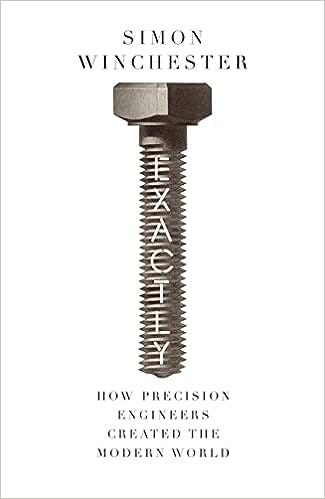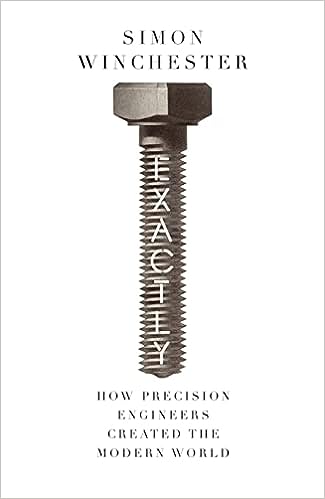Exactly is a book about the story of precision and how the endless march of precision has been made possible by practical needs in our world. The author illustrates this through the stories of various inventions and the men who pushed the boundaries of what was known at the time to deliver a product far superior to anything that existed.

He starts the book by examining the difference between accuracy and precision. You can be accurate without being precise. A copy of the Mona Lisa is accurate, but precision would be having Mona Lisa itself.
The story of precision is not just about the products that needed to be precise but also the machines that had to be invented to deliver that precision.
Every chapter in the book is the story of the next leap in precision. 0.1 metre to 0.001 metre to 0.00001 and so on.
The book starts out in the battle trenches of the English war against the Americans in the early 19th century. Every gun used to be handmade and if a trigger failed on a gun, there was no way to replace the trigger without having someone take precise measurements and hand-make and deliver the exact part needed for that gun. It was in these circumstances that Thomas Jefferson heard about the casting of exact parts in France that could be used to replace. This unleashed the first pursuits of precision.
Then came the need to cast perfect cannons. In England, the cannons used to be cast and the hollows of the cannon could have deformities. This would result in the cannonball being misdirected. The solution was to cast a solid iron block and then remove the iron from within to get the perfect size and shape. This same technique was later used to produce the cylinders for the steam engine.
It was John Wilkinson who came up with the idea of making cannons in this fashion and on the request of an engineer by the name of James Watt, he produced the first cylinders. While the process for making a cannon was patented, he did not bother to patent the process of making a cylinder using the same technique. This allowed James Watt to create his own patent.
Incidentally, the requirement to perform this process repeatedly gave birth to the lathe machine which became the preferred way to bore holes in cast metal.
Clocks and Locks delivered the next leap in precision. At the time clocks were often inaccurate and this made keeping time at sea a huge challenge. Clocks also needed smaller and more intricate parts in them. This required new manufacturing processes, new machines to fabricate and a focus on precision which had not thus far been seen. Joseph Bramah in the meantime created a lock called the Bramah lock which was near impossible to break. In fact, his store used to have an open challenge on the front showcase. The challenge was that if anyone could break the lock, they would be given 200 pounds. It was only after his death that someone managed to break the lock and it took him 60 hours and a bevy of specialised instruments, which only further established the fame of the locksmith.
The next leap was brought by cars that required greater precision to build. Unlike steam engines, cars had much smaller engines and needed to be produced with higher degrees of precision. This is the point at which 2 Henrys on either side of the Atlantic took two very different approaches. Henry Royce built a car that was millimetre perfect and extremely precise in all of its workings. It was said that a Rolls engine was so precisely manufactured that without friction it would run forever once started up. Henry Ford on the other hand wanted to make cars that used as few parts as possible and one where every part could be replaced with another from any of his cars. His quest for precision gave us the production line. So where Rolls was churning out 2 cars a day, Ford was producing a hundred a day.
The introduction of aviation meant even more extreme performance expectations. Most planes fly at sub-zero temperatures today but even at the beginning of the jet age, the machines were required to perform at high variance of parameters such as temperatures and without failure. This quest not only brought us many more novel manufacturing methods it also pushed the envelope of the materials that we used in manufacturing.
Then came the space race which require a whole new level of tolerance and engineering to create machines that could function at zero degrees Kelvin. The story of the Hubble telescope which was rendered useless because the glass was ground wrong by 1/50th of the width of a human hair is a fine example here. These undertakings pushed our requirements for precision to a whole new level.
The most precise manufacturing that there is today is one that we carry around in our pockets today. The silicon chips used in our phones and over devices are produced by cramming millions, even billions of transistors onto an area the size of the tip of your finger. This requires a level of precision and manufacturing that is hard for the human mind to comprehend. It is done using lasers. Transistors today are produced to exacting standards and are just 3 atoms wide.
While the writer walks us through each of these leaps he leaves us with a thought at the end.
The mark of first-rate intelligence is the ability to hold two contradicting ideas in the mind and still can function normally.
Our pursuit of precision has brought us to a place where we seek out the ever more precise. The Japanese were the inventors of the quartz watch which was a huge leap in timekeeping precision. Ginza, the same city where Seiko, the company that invented the quartz watch, is based, is also famous for its handmade teacups. The Teacups are a reflection of an ancient craft, each cup is unique and that is what gives it value. It is anything but precise but still valued.
In our pursuit of the precise, we should not lose our ability to appreciate the imprecise.
Overall an incredible read, even more so if you have studied manufacturing or worked in manufacturing or just love watching videos of things being made on youtube or Facebook. I would highly recommend this book.


Leave a Reply